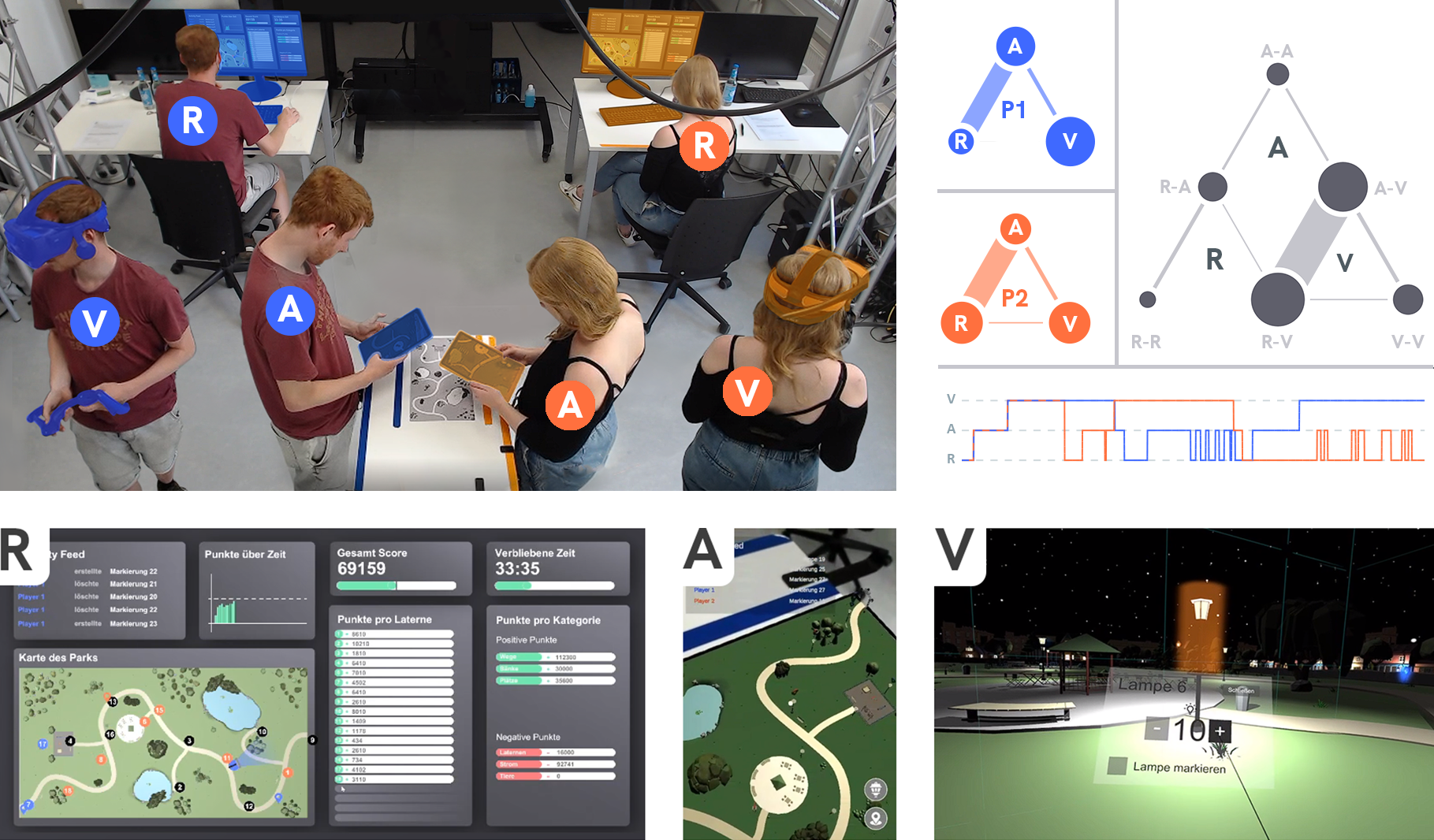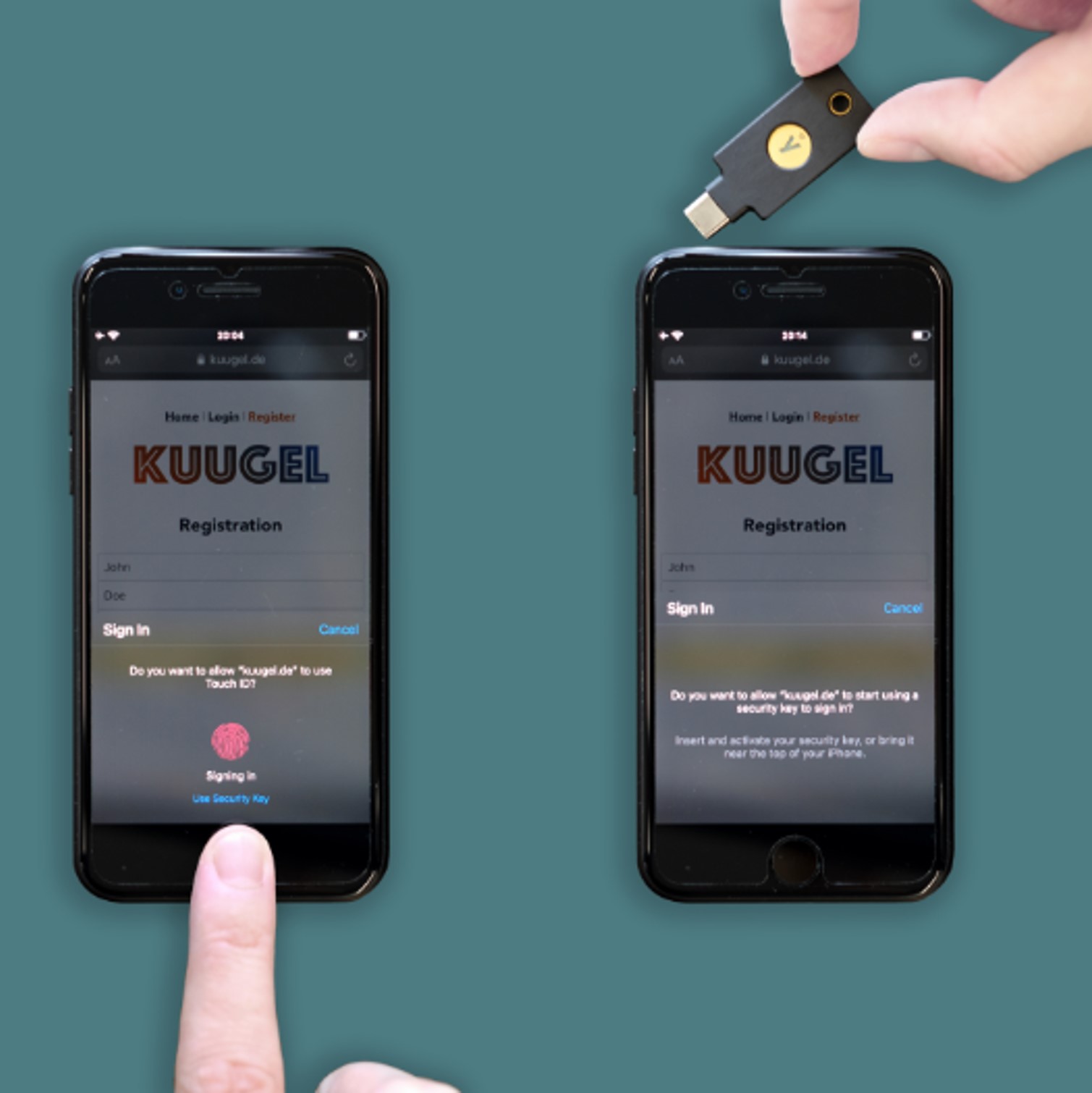We curated a list of this year’s publications — including links to social media, lab websites, and supplemental material. We have six journal articles, 67 full papers, 30 LBWs, eleven interactivities, one alt.chi paper, one DC paper, lead three workshops and give two courses. Four papers were awarded a best paper award, and seven papers received an honourable mention.
The papers for the contributing labs were also curated in a PDF booklet by Michael Chamunorwa, and it can be downloaded here: Booklet 2023
Your publication is missing? Send us an email: contact@germanhci.de
Collaborating Across Realities: Analytical Lenses for Understanding Dyadic Collaboration in Transitional Interfaces
Jan-Henrik Schröder (University of Lübeck), Daniel Schacht (University of Lübeck), Niklas Peper (University of Lübeck), Anita Marie Hamurculu (University of Lübeck), Hans-Christian Jetter (University of Lübeck)
Abstract | Tags: Best Paper, Full Paper | Links:
@inproceedings{Schroeder2023Transitional,
title = {Collaborating Across Realities: Analytical Lenses for Understanding Dyadic Collaboration in Transitional Interfaces},
author = {Jan-Henrik Schröder (University of Lübeck), Daniel Schacht (University of Lübeck), Niklas Peper (University of Lübeck), Anita Marie Hamurculu (University of Lübeck), Hans-Christian Jetter (University of Lübeck)},
url = {https://www.imis.uni-luebeck.de/de/institut/professuren/professur-fuer-interaktionsdesign-und-user-experience, Website
},
doi = {10.1145/3544548.3580879},
year = {2023},
date = {2023-04-28},
urldate = {2023-04-28},
publisher = {ACM},
abstract = {Transitional Interfaces are a yet underexplored, emerging class of cross-reality user interfaces that enable users to freely move along the reality-virtuality continuum during collaboration. To analyze and understand how such collaboration unfolds, we propose four analytical lenses derived from an exploratory study of transitional collaboration with 15 dyads. While solving a complex spatial optimization task, participants could freely switch between three contexts, each with different displays (desktop screens, tablet-based augmented reality, head-mounted virtual reality), input techniques (mouse, touch, handheld controllers), and visual representations (monoscopic and allocentric 2D/3D maps, stereoscopic egocentric views). Using the rich qualitative and quantitative data from our study, we evaluated participants' perceptions of transitional collaboration and identified commonalities and differences between dyads. We then derived four lenses including metrics and visualizations to analyze key aspects of transitional collaboration: (1) place and distance, (2) temporal patterns, (3) group use of contexts, (4) individual use of contexts.},
keywords = {Best Paper, Full Paper},
pubstate = {published},
tppubtype = {inproceedings}
}

FIDO2 the Rescue? Platform vs. Roaming Authentication on Smartphones
Leon Würsching (Secure Mobile Networking Lab, TU Darmstadt, Darmstadt, Germany), Florentin Putz (Secure Mobile Networking Lab, TU Darmstadt, Darmstadt, Germany), Steffen Haesler (Science, Technology for Peace, Security (PEASEC), Technische Universität Darmstadt, Darmstadt, Germany), Prof. Dr. Matthias Hollick (Secure Mobile Networking Lab, TU Darmstadt, Darmstadt, Germany)
Abstract | Tags: Best Paper, Full Paper | Links:
@inproceedings{wuerschiing2023fido,
title = {FIDO2 the Rescue? Platform vs. Roaming Authentication on Smartphones},
author = {Leon Würsching (Secure Mobile Networking Lab, TU Darmstadt, Darmstadt, Germany), Florentin Putz (Secure Mobile Networking Lab, TU Darmstadt, Darmstadt, Germany), Steffen Haesler (Science and Technology for Peace and Security (PEASEC), Technische Universität Darmstadt, Darmstadt, Germany), Prof. Dr. Matthias Hollick (Secure Mobile Networking Lab, TU Darmstadt, Darmstadt, Germany)},
url = {https://www.teamdarmstadt.de/, website},
doi = {10.1145/3544548.3580993},
year = {2023},
date = {2023-04-23},
abstract = {Modern smartphones support FIDO2 passwordless authentication using either external security keys or internal biometric authentication, but it is unclear whether users appreciate and accept these new forms of web authentication for their own accounts. We present the first large-scale lab study (N=87) of platform compared to roaming authentication on smartphones, determining the practical strengths and weaknesses of FIDO2 as perceived by users in a mobile scenario. Most participants indicated a general willingness to adopt passwordless authentication during our in-person user study, but closer analysis shows that participants prioritize usability, security, and availability differently depending on the account type. We identify remaining adoption barriers that prevent FIDO2 from succeeding password authentication, such as missing support for contemporary usage patterns, including account delegation and usage on multiple clients.},
keywords = {Best Paper, Full Paper},
pubstate = {published},
tppubtype = {inproceedings}
}

Going, Going, Gone: Exploring Intention Communication for Multi-User Locomotion in Virtual Reality
Julian Rasch (LMU Munich), Vladislav Dmitrievic Rusakov (LMU Munich), Martin Schmitz (Saarland University, Saarland Informatics Campus), Florian Müller (LMU Munich)
Abstract | Tags: Best Paper, Full Paper | Links:
@inproceedings{Rasch2023Going,
title = {Going, Going, Gone: Exploring Intention Communication for Multi-User Locomotion in Virtual Reality},
author = {Julian Rasch (LMU Munich), Vladislav Dmitrievic Rusakov (LMU Munich), Martin Schmitz (Saarland University, Saarland Informatics Campus), Florian Müller (LMU Munich)},
url = {https://julian-rasch.com, Website
https://www.linkedin.com/in/julian-rasch, LinkedIn
},
doi = {10.1145/3544548.3581259},
year = {2023},
date = {2023-04-28},
urldate = {2023-04-28},
publisher = {ACM},
abstract = {Exploring virtual worlds together with others adds a social component to the Virtual Reality (VR) experience that increases connectedness. In the physical world, joint locomotion comes naturally through implicit intention communication and subsequent adjustments of the movement patterns. In VR, however, discrete locomotion techniques such as point&teleport come without prior intention communication, hampering the collective experience. Related work proposes fixed groups, with a single person controlling the group movement, resulting in the loss of individual movement capabilities. To close the gap and mediate between these two extremes, we introduce three intention communication methods and explore them with two baseline methods. We contribute the results of a controlled experiment (n=20) investigating these methods from the perspective of a leader and a follower in a dyadic locomotion task. Our results suggest shared visualizations support the understanding of movement intentions, increasing the group feeling while maintaining individual freedom of movement.},
keywords = {Best Paper, Full Paper},
pubstate = {published},
tppubtype = {inproceedings}
}
The Walking Talking Stick: Understanding Automated Note-Taking in Walking Meetings
Luke Haliburton (LMU Munich), Natalia Bartłomiejczyk (Lodz University of Technology), Albrecht Schmidt (LMU Munich), Paweł W. Woźniak (Chalmers University), Jasmin Niess (Oslo University)
Abstract | Tags: Best Paper, Full Paper | Links:
@inproceedings{Haliburton2023Walking,
title = {The Walking Talking Stick: Understanding Automated Note-Taking in Walking Meetings},
author = {Luke Haliburton (LMU Munich), Natalia Bartłomiejczyk (Lodz University of Technology), Albrecht Schmidt (LMU Munich), Paweł W. Woźniak (Chalmers University), Jasmin Niess (Oslo University)},
url = {https://www.instagram.com/mediagroup.lmu/, Instagram},
doi = {10.1145/3544548.3580986},
year = {2023},
date = {2023-04-28},
urldate = {2023-04-28},
publisher = {ACM},
abstract = {While walking meetings offer a healthy alternative to sit-down meetings, they also pose practical challenges. Taking notes is difficult while walking, which limits the potential of walking meetings. To address this, we designed the prototype{}---a tangible device with integrated voice recording, transcription, and a physical highlighting button to facilitate note-taking during walking meetings. We investigated our system in a three-condition between-subjects user study with thirty pairs of participants (N=60) who conducted 15-minute outdoor walking meetings. Participants either used lapel microphones, the prototype without the button, or the prototype with the highlighting button. We found that the tangible device increased task focus, and the physical highlighting button facilitated turn-taking and resulted in more useful notes. Our work demonstrates how interactive artifacts can incentivize users to hold meetings in motion and enhance conversation dynamics. We contribute insights for future systems which support conducting work tasks in mobile environments.},
keywords = {Best Paper, Full Paper},
pubstate = {published},
tppubtype = {inproceedings}
}